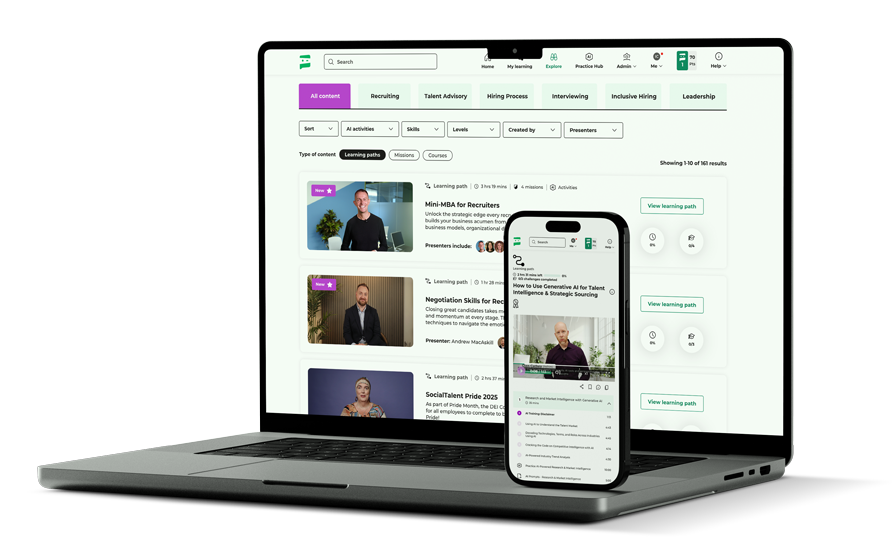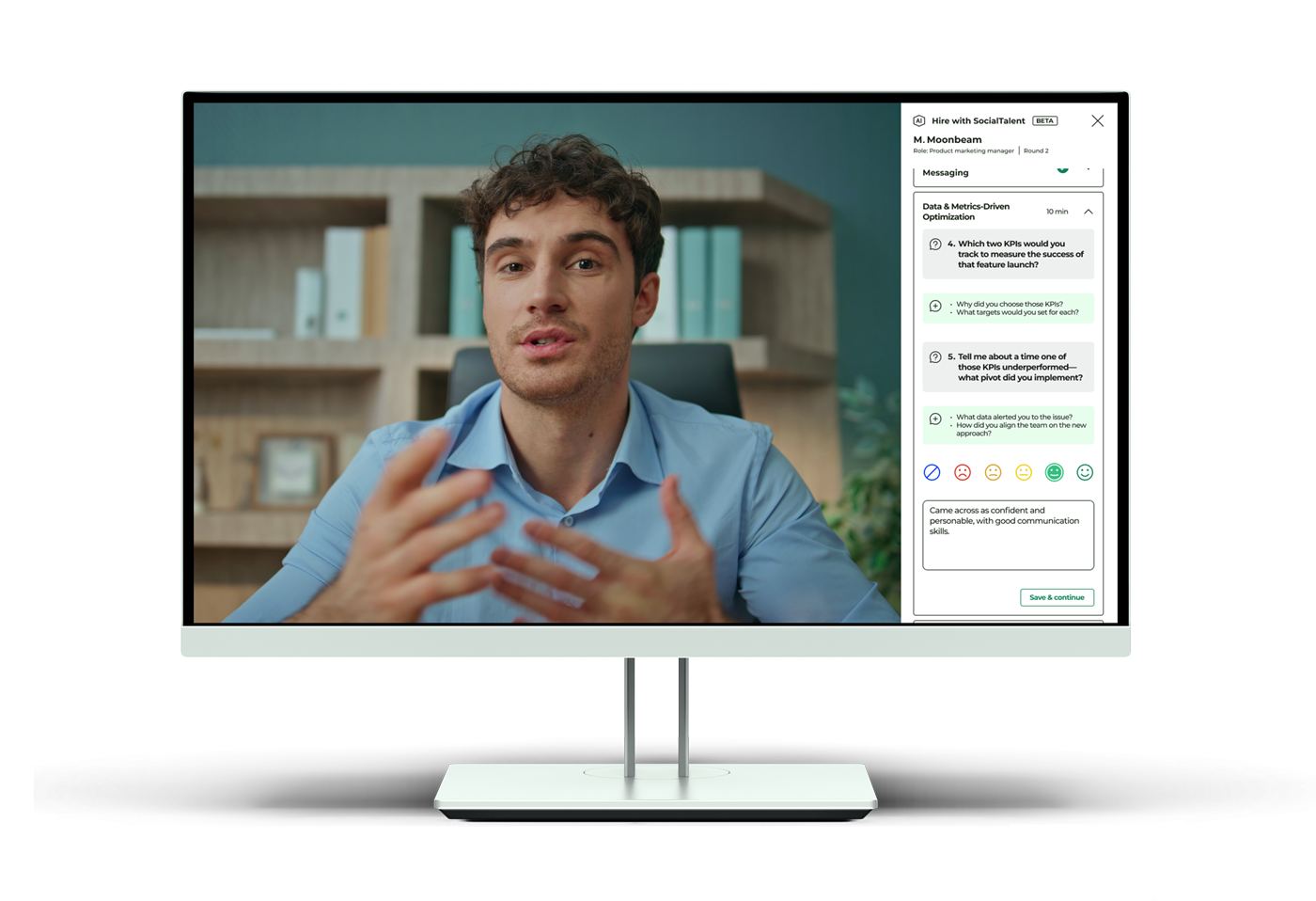
By Johnny Campbell
Everyone says they want their recruiters to “be more strategic.”
But when it comes time to ask for investment – whether it’s training your team, buying new TA technology, or getting headcount approval – the question from leadership is always the same:
“What’s the ROI?”
And that’s where many Talent Acquisition leaders freeze.
Because even if your team adopts a Talent Advisor mindset and starts demonstrating talent advisory behaviors, how do you actually prove it? More importantly: does the business even care?
This was a central theme at our recent SocialTalent Live event, where top TA leaders explored how they’re managing the shift from recruiter to Talent Advisor 2.0 – and what ROI really looks like.
Measuring the Move to Talent Advisor
I recently spoke with a TA leader who had done everything right: invested in upskilling, aligned recruitment to business strategy, and coached her team to think and act like true Talent Advisors.
When I asked how she measured success, she shared two approaches:
1. The Qualitative
Hiring manager surveys asked specific questions like:
- “Did your recruiter show up with market insights?”
- “Was there a robust hiring plan?”
- “Did they challenge assumptions and share relevant data?”
This helped track capability uplift. Not vague satisfaction scores, but tangible proof that Talent Advisor behaviors were showing up in real interactions.
2. The Quantitative
They also tracked:
- Candidate-to-interview ratios (better role alignment)
- Time between interview stages (improved collaboration)
- Offer acceptance rates (stronger candidate experience)
Together, these showed real progress. But here’s the kicker: even if you can prove someone has become a Talent Advisor, it doesn’t mean the business will care.
Does the Business Care If You’re a Talent Advisor?
Here’s the uncomfortable truth.
You’re proud of your team’s transformation. Maybe you’ve even got data to back it up. But when it’s time to face the CFO or CEO, they want one clear metric that shows performance.
And most TA leaders fall back on the old standby: cost-per-hire.
That’s a problem.
Cost-per-hire is simple and seductive. It looks objective. It often improves when you automate or cut corners. But it’s also dangerously misleading.
When cost becomes the only lens, you lose sight of talent quality, strategic alignment, and long-term impact. In fact, with AI accelerating sourcing and screening, it’s easy for leaders to ask:
“Why do we need recruiters at all?”
As John Vlastelica noted during his panel at SocialTalent Live, the future of recruiting isn’t about knowing what to do – it’s about influencing, guiding, and creating change. That’s the job of a Talent Advisor.
But how do you equate that with cost?
Learn more: Redefining Talent Acquisition: From Cost Center to Value Driver
Reframing the Narrative: Total Cost of Recruiting
When I briefly worked in IT, I came across the concept of Total Cost of Ownership (TCO). It highlights how a cheaper upfront cost can lead to higher expenses long term due to maintenance, inefficiencies, or downtime.
Talent Acquisition needs its own version:
Total Cost of Recruiting.
This includes:
- Recruiter salaries and tools (traditional cost-per-hire)
- First-year attrition
- Above-market salaries from poor negotiation
- Revenue lost from hiring delays
- Productivity drag from poor-fit hires
A great Talent Advisor influences all of these.
Example: your recruiters are trained in negotiation and stakeholder management. They set expectations early and align on realistic hiring profiles. The result? Mid-band offers instead of max-band, saving $3–5k per hire. Across hundreds of hires, that’s a major ROI on your talent advisory investment.
Or take first-year attrition. Advisory-led hiring reduces poor-fit hires, which saves on onboarding, training, and re-hiring costs.
Learn more: What is the Real Cost of a Bad Hire?
But What If Cost Is the Strategy?
Let’s be real: some businesses are in cost-control mode. In low-margin environments, HR is seen as overhead. You may not get the chance to talk about qualitative impact.
Fine. Let’s speak their language.
If cost-per-hire is your mandated metric, go deeper:
- Could better negotiation reduce average offer amounts?
- Could Talent Advisors reduce agency dependency?
- Could strategic advisory reduce the need for backfilling?
- Could better alignment increase productivity and retention?
Now, your Talent Advisors aren’t a cost – they’re cost savers.
Diane Circo from Sprout Social highlighted this during her SocialTalent Live panel. In just 12 months, their recruiters embraced Talent Advisor behaviors and:
- Cleared a 2-year backlog of open roles
- Achieved 96% hiring target completion
- Increased offer acceptance rates
That’s real, measurable business impact.
Advisory Behavior = Business Impact
This is the shift.
Stop trying to prove Talent Advisor success just to feel validated. Prove it because it moves the business.
If you’re facing pushback on your strategic TA investments, flip the script:
- Link faster time-to-hire in sales to revenue gains
- Show how clearer specs shorten pipelines and reduce interview volume
- Highlight how better advisory reduces offer variability and salary inflation
- Prove that hiring right reduces churn and onboarding costs
Every business-critical metric can be connected to Talent Advisor behavior – you just need to tell the right story.
Final Thought: Show the Math
2025 is not the year for fluffy narratives. If you can’t tie your Talent Acquisition investments to measurable business results, you won’t get the budget – no matter how good your story sounds.
So take a page from the TCO playbook.
Stop optimizing for what’s easy to measure, and start optimizing for what matters.
You already know what great hiring looks like. Now it’s time to show them the math.
This article originally appeared in Johnny Campbell’s Talent Leadership Insights LinkedIn newsletter. Click here to subscribe!




